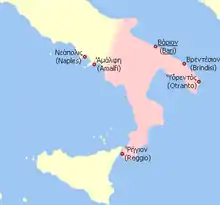| Catepanate of Italy Κατεπανίκιον Ἰταλίας | |||||||||||
|---|---|---|---|---|---|---|---|---|---|---|---|
| Province of the Byzantine Empire | |||||||||||
| 965–1071 | |||||||||||
 Approximate territorial extent of the Catapanate of Italy during the early 11th century. Modern city names (in Italian, except from Napoli) are provided alongside the medieval Greek names. | |||||||||||
| Capital | Bari | ||||||||||
| Historical era | Middle Ages | ||||||||||
• Established | 965 | ||||||||||
| 1071 | |||||||||||
| |||||||||||
| Today part of | Italy | ||||||||||
The Catepanate (or Catapanate) of Italy (Greek: κατεπανίκιον Ἰταλίας Katepaníkion Italías) was a province of the Byzantine Empire from 965 until 1071. At its greatest extent, it comprised mainland Italy south of a line drawn from Monte Gargano to the Gulf of Salerno. North of that line, Amalfi and Naples also maintained allegiance to Constantinople through the catepan. The Italian region of Capitanata derives its name from katepanikion.
History
Following the fall of the Exarchate of Ravenna in 751, Byzantium had been absent from the affairs of southern Italy for almost a century, but the accession of Basil I (reigned 867–886) to the throne of Constantinople changed this: from 868 on, the imperial fleet and Byzantine diplomats were employed in an effort to secure the Adriatic Sea from Saracen raids, re-establish Byzantine dominance over Dalmatia, and extend Byzantine control once more over parts of Italy.[1] As a result of these efforts, Otranto was taken from the Saracens in 873, and Bari, captured from Arabs by the Holy Roman Emperor Louis II in 871, passed under Byzantine control in 876.[2] The expeditions of the capable general Nikephoros Phokas the Elder in the mid-880s further extended Byzantine control over most of Apulia and Calabria.[3] These victories were followed up by his successors and laid the foundation of a resurgence of Byzantine power in southern Italy, culminating in the establishment of the theme of Longobardia in c. 892. The regions of Apulia, Calabria and Basilicata would remain firmly under Byzantine control until the 11th century.[4] In c. 965, a new theme of Lucania was established, and the stratēgos (military governor) of Bari was raised to the title of katepanō of Italy, usually with the rank of patrikios. The title of katepanō meant "the uppermost" in Greek. This elevation was deemed militarily necessary after the final loss of nearby Sicily, a previously Byzantine possession, to the Arabs.
Some Norman adventurers, on pilgrimage to Monte Sant'Angelo sul Gargano, lent their swords in 1017 to the Lombard cities of Apulia against the Byzantines. From 1016 to 1030 the Normans were pure mercenaries, serving either Byzantine or Lombard, and then Duke Sergius IV of Naples, by installing their leader Ranulf Drengot in the fortress of Aversa in 1030. This gave the Normans their first foothold in southern Italy from which they began an organized conquest of the land. In 1030, William and Drogo, the two eldest sons of Tancred of Hauteville, a noble of Coutances in Normandy arrived in southern Italy. The two joined in the organized attempt to wrest Apulia from the Byzantines, who had lost most of that province by 1040. Bari was captured by the Normans in April 1071, and Byzantine authority was finally terminated in Italy, five centuries after the conquests of Justinian I. In 1154-1156, through a plan hatched by Emperor Manuel I Komnenos, the Byzantines returned briefly to besiege Bari and were moderately successful in inciting a mass revolt which nearly toppled Norman control (potentially handing much of the former Katepanate back to the Byzantine Empire), but the gains were "reversed by misfortune".[5][6]
The title Catapan of Apulia and Campania was revived briefly in 1166 for Gilbert, Count of Gravina, the cousin of the queen regent Margaret of Navarre. In 1167, with his authority as catapan, Gilbert forced German troops out of the Campania and compelled Frederick Barbarossa to raise the siege of Ancona.
Catepans
- 970–975 Michael Abidelas
- before 982 Romanos
- 982–985 Kalokyros Delphinas
- 985–988 Romanos
- 988–998 John Ammiropoulos
- 999–1006 Gregory Tarchaneiotes
- 1006–1008 Alexios Xiphias
- 1008–1010 John Kourkouas
- 1010–1016 Basil Mesardonites
- May 1017 – December 1017 Leo Tornikios Kontoleon
- December 1017 – 1027 Basil Boioannes
- c. 1027–1029 Christophoros Burgaris
- July 1029 – June 1032 Pothos Argyros
- 1032 – May 1033 Michael Protospatharios
- May 1033 – 1038 Constantine Opos
- 1038–1039 Michael Spondyles
- February 1039 – January 1040 Nikephoros Dokeianos
- November 1040 – Summer of 1041 Michael Dokeianos
- Summer 1041 – 1042 Exaugustus Boioannes
- February 1042 – April 1042 Synodianos
- April 1042 – September 1042 George Maniakes
- Autumn 1042 Pardos
- February 1043 – April 1043 Basil Theodorokanos
- Autumn 1045 – September 1046 Eustathios Palatinos
- September 1046 – December 1046 John Raphael
- 1050–1058 Argyrus
- 1060/1061 Marules
- 1062 Sirianus
- 1064–1068 Abulchares
- 1068 Perenos
- 1071 Stephen Pateranos
References
- ↑ Kreutz 1996, pp. 41–43.
- ↑ Kreutz 1996, p. 57.
- ↑ Kreutz 1996, p. 63.
- ↑ Kreutz 1996, pp. 63–66, 68.
- ↑ Kinnamos. The Deeds of John and Manuel Komnenos.
- ↑ Choniates. Historia.
Sources
- Charanis, Peter. "On the Question of the Hellenization of Sicily and Southern Italy During the Middle Ages." The American Historical Review. Vol. 52, No. 1 (Oct., 1946), pp. 74–86.
- Kreutz, Barbara M. (1996). Before the Normans: Southern Italy in the Ninth and Tenth Centuries. Philadelphia: University of Pennsylvania Press. ISBN 0-8122-1587-7.
- Loud, G.A. (2006). "Southern Italy in the tenth century". In Reuter, Timothy (ed.). The New Cambridge Medieval History, Volume III c. 900–c. 1204. Cambridge University Press. pp. 624–645. ISBN 978-0-521-36447-8.
- Loud, Graham (2013). The Age of Robert Guiscard: Southern Italy and the Northern Conquest. New York: Routledge. ISBN 978-0-582-04529-3.
- White, Lynn, Jr.. "The Byzantinization of Sicily." The American Historical Review. Vol. 42, No. 1 (Oct., 1936), pp. 1–21.